Abstract
This paper investigates the dynamical characteristics of the Boissonade model in a class of reaction–diffusion chemical systems with time delays, analyzing the system’s Hopf bifurcation with time delay as the parameter under both diffusion-free and diffusion-included conditions. First, the stability of the positive equilibrium solution is examined in the absence of diffusion, with stability criteria derived for different parameter ranges. This analysis confirms that a Hopf bifurcation occurs near the positive equilibrium, revealing that the system exhibits periodic oscillations once the time delay exceeds a critical threshold. Subsequently, the impact of the diffusion term on the Hopf bifurcation is investigated, and the critical threshold for its occurrence is determined. Finally, numerical simulations are conducted, providing comprehensive numerical validation for the theoretical findings.
MSC:
35B32; 34K20
1. Introduction
In the mid-20th century, the experimental results of the Belousov–Zhabotinsky reaction demonstrated that, under conditions far from equilibrium, specific chemical reaction systems can exhibit periodic concentration oscillations. This phenomenon challenged the traditional thermodynamic framework, which posits that “chemical reactions are inherently irreversible and invariably approach equilibrium”. Identifying such nonequilibrium oscillatory systems elevated chemical dynamics to a crucial position in the study of complex systems and self-organization phenomena, thus laying a robust groundwork for advancing nonlinear science.
To elucidate the fundamental mechanisms governing chemical oscillatory phenomena [,] in chemical reactions, researchers have introduced a variety of theoretical models, such as the Brusselator model [,,], the Oregonator model [,], and the Boissonade model [,,], among others. Under plausible dynamical postulates, these chemical reaction models not only reproduce the experimentally observed Hopf bifurcation and limit cycle oscillations [,,,] but also exhibit chaotic dynamics [,,] under suitably selected parameter regimes. Furthermore, when diffusion phenomena are considered, these chemical models are capable of generating Turing patterns [,,], thereby offering a theoretical framework for exploring the emergence of patterns and non-equilibrium steady states. Chemical reaction models hold considerable significance not only within the domain of physical chemistry but also in mathematical investigations, with particular emphasis on the Boissonade model, which epitomizes a quintessential example of low-dimensional nonlinear ordinary differential equations. Due to its concise equation form and well-defined dynamic characteristics, this model is often extended to account for stochastic noise and unbounded domains []. Additionally, the spatial patterns demonstrated by the reaction–diffusion framework of the Boissonade model provide mathematical support for self-organization within intricate systems [].
The Boissonade model has been proposed by French scholars V. Duffet and J. Boissonade []:
Here, u and v represent the concentrations of two substances in the chemical reaction. Specifically, u is the activator, while v is the inhibitor. The parameters are strictly positive control parameters that characterize the intensity of the reaction between the two chemical substances. In the context of this dynamical system, the parameter a is typically associated with the rate of reaction or the strength of inhibition. Parameter b characterizes the self-consumption or natural decay rate of the variable v, while the parameter r generally corresponds to the intensity of positive feedback within the reaction. The first governing equation, which is outlined in the reference model, u represents the linear self-proliferation term, while denotes the linear suppression term, the term breaks the symmetry of in the chemical system, which is atypical in chemical systems. The term serves to restrict the exponential growth of disturbances and allows for the saturation of instability.The second governing equation, which is outlined in the reference model, u constitutes the linear excitation term, whereas signifies the linear autodegradation term.
Due to the phenomenon of diffusion between molecules of chemical substances during chemical reactions, Zhang investigated the following reaction–diffusion Boissonade model []
The author employed center manifold theory and the method of normal forms to investigate the pattern formation mechanisms of the model (2), as well as dynamic behaviors such as Hopf bifurcation and Turing bifurcation.
Liu investigated the invariant manifolds of the following non-autonomous Boissonade system defined on a three-dimensional torus []
This model exhibits a Turing structure, functioning as an activation-inhibition model that delineates the relationship between the real homogeneous two-dimensional system and its corresponding three-dimensional monolayer configuration.
Furthermore, academics have conducted an in-depth analysis of a simplified Boissonade–De Kepper model incorporating time-delayed feedback [].
This investigation reveals that the quadratic term consistently induces a subcritical Hopf bifurcation, while the cubic term facilitates a transition of the model between subcritical and supercritical bifurcations. This research uncovers the subtle interplay between the nonlinear terms and the resulting system dynamics.
The Boissonade model has found broader applications across various fields of research, including chemical reactions [], pattern formation [], and chaotic dynamics [], enabling the model to describe more intricate nonlinear system behaviors.
This study principally explores the Boissonade model with time delay effects:
From this set, is a bounded open domain in , and is a Laplacian operator in . u and v are the concentrations of the two chemical compounds within the chemical process, and r are positive parameters used to characterize the intensity of the interaction dynamics of the two chemical compounds, and and correspond to the diffusivity parameters of u and v, respectively.
Through computation, it is determined that System (5) possesses three equilibrium points: , , and .
Among these, , , , and .
When the condition is satisfied, represents the positive equilibrium point. When condition and , system (5) admits two positive equilibrium points, and .
This manuscript’s research predominantly examines the Hopf bifurcation at the positive equilibrium point of system (5) with time delay as a parameter.
2. Existence of Hopf Bifurcation in the Model Without Diffusion
The structure of system (5) without diffusion is specified as
This section investigates the stability and Hopf bifurcation of the system based on the methodology established in reference []. The linearized equation of system (6) at the equilibrium point is given by
in which , .
The fundamental equation governing system (7) is
is not an eigenvalue of the characteristic Equation (8).
In the case that , Equation (8) undergoes a transformation to
Assuming that and are the two solutions of Equation (9), the calculations yield and . Thus, the solutions of Equation (9) are characterized by negative real components.
Case 1: ,
As long as , , the characteristic Equation (8) is reformulated as
Assuming that constitutes a pair of purely imaginary eigenvalues of the characteristic Equation (10) and substituting into the characteristic Equation (10) to separate the real part and the imaginary part, we obtain
This calculation yields
wherein and .
By reflecting this on the line , Equation (12) emerges as
It has been demonstrated that when and , and Equation (13) yields a positive real solution. The positive solution of Equation (13) is formulated as ; concretely, . From Equation (11),
It is established that ; the pivotal threshold of the time delay is
We postulate that and differentiate both sides of Equation (10) with respect to to ascertain
Accordingly,
It is established that when holds, .
We assume that
(Q1):
(Q2):
Theorem 1.
Regarding model (6), when , , and conditions and are met, then the positive equilibrium point of the model exhibits local asymptotic stability at . When , the positive equilibrium state of the model exhibits instability, and a Hopf bifurcation appears at .
Case 2: and
Given that and , the characteristic Equation (8) is represented as
We suppose that represents a pair of purely imaginary solutions of the characteristic Equation (17), and is plugged into the characteristic Formula (17) to distinguish between the real and imaginary components:
Then, through calculation, we obtain
in which , , and .
On the condition that , , Equation (19) contains at least one positive real zero. Without compromising generality, the two eigenvalues of Equation (19) are characterized as and ; specifically, or . Equation (18) is solvable:
- (a):
- When ; , or , , and ,
- (b):
- When , , and ,
Consider the condition or and ; then, Equation (17) is computed by differentiating at both boundaries with respect to :
We can then obtain
Additionally, it follows that
such that and
Therefore, when is satisfied, there exists .
We assume that
(Q3):
(Q4):
Theorem 2.
In the case of model (6), when , , and conditions and are satisfied, then the positive equilibrium point of the model is locally asymptotically stable at . When , the positive equilibrium point of the model is unstable, and a Hopf bifurcation is observed at .
Case 3: .
In the event that , the characteristic Equation (8) is reinterpreted as
We postulate that denotes a pair of purely imaginary values of the characteristic Equation (24) and substitute into Equation (24). After decomposing it into real and imaginary components, the equation becomes
Rearranged, it yields
for which and .
In the situation where , , Equation (26) possesses at least one positive real solution. Without narrowing the scope of generality, the two eigenvalues of Equation (26) are specified as and , which means that or . From Equation (25), we obtain
From this, we can calculate the following:
- (a):
- When or and ,
- (b):
- When and ,
We define or , and derive the derivative of Equation (24) with respect to at both boundaries:
Hence,
Subsequently,
In this case, , , , and .
Evidently, assuming that holds, it follows that there exists .
We assume that
(Q5):
(Q6):
Theorem 3.
In terms of model (6), if and conditions and are satisfied, the positive equilibrium point of the model is asymptotically stable in the vicinity of . If , the positive equilibrium point of the model is unstable, and a Hopf bifurcation is observed at .
3. Existence of Hopf Bifurcation in the Model with Diffusion
Case 1: , .
In the case where and , model (5) undergoes linearization at the positive equilibrium point :
In accordance with (31), the characteristic equation is deduced:
under which
It is straightforward to demonstrate that is not a solution to the characteristic Equation (32).
Under the condition that , Equation (32) simplifies to
Let and represent any two roots of Equation (34), a fact that can be readily demonstrated:
Lemma 1.
When , the positive equilibrium point of the system exhibits local asymptotic stability.
We assume that is the characteristic root of Equation (32) and substitute it into Equation (32) to decompose it into real and imaginary parts:
The calculation of Equation (36) yields
This simplifies to
At the point where , , .
It is straightforward to demonstrate that and .
- (A1):
- For an arbitrary value of , and . In the case that holds, Equation (38) does not admit any positive roots. Consequently, Equation (32) has no purely imaginary roots.
- (A2):
- There exists a such that and . Provided that condition is satisfied, Equation (32) possesses a pair of purely imaginary roots, .
Given that
by inserting into Equation (36), we obtain
The computation reveals that .
Consequently,
As is apparent, constitutes a monotonically increasing sequence, and , represented as .
Lemma 2.
Assume that is the characteristic root of Equation (32) near , fulfilling the conditions , , and . If condition is satisfied, then
Proof.
Take the derivative of both sides of Equation (32) with respect to :
Compute the real component:
Insert (39) into the preceding equation:
According to Lemmas 1 and 2, the following results are derived. □
Theorem 4.
Assuming that , the following conclusion holds:
- (i)
- If condition holds, then when , the positive equilibrium point of system (5) is locally asymptotically stable;
- (ii)
- When condition is satisfied and , the positive equilibrium point of system (5) is locally asymptotically stable. When , the positive equilibrium point of the system is unstable. When , with , Hopf bifurcation occurs at the positive equilibrium point ; that is, near , the system generates a periodic solution from the positive equilibrium point .
Case 2: , .
When and , the linearized system of model (5) at the positive equilibrium point is given by
The characteristic Equation (42) is given by
Considering that
for , Equation (43) takes the form
Let and denote any two roots of Equation (45), which are permitted to be easily established:
Lemma 3.
When , the positive equilibrium point of the system demonstrates local asymptotic stability.
We let represent the characteristic root of Equation (43) and insert it into Equation (43) to distinguish between the real and imaginary components:
Then, we can calculate
as defined by , , and .
It is trivial to show that .
- (B1):
- For an arbitrary value of and .
- (B2):
- There exists a such that and .
Given that condition is satisfied, Equation (48) exhibits a pair of pure imaginary roots, .
In the case of
substituting the value of into Equation (47) produces
From Equation (50), it is inferred that
It is evident that defines a strictly increasing sequence and , denoted by .
Lemma 4.
We consider as the characteristic root of Equation (43) close to , satisfying conditions , , and . If condition holds true, then
Proof.
We apply differentiation to both sides of Equation (43) with respect to :
Then, we assess the real component:
This gives the following numerical results:
- (B3):
- There exists a such that , , and .
Given that condition is satisfied, Equation (43) exhibits a pair of pure imaginary roots, , .
For the condition that
plug into Equation (47):
Based on Equation (52),
□
Utilizing a proof method comparable to Lemma 4, the following inferences are subject to being drawn:
Lemma 5.
Let be the characteristic root of Equation (43) close to , , , and the conditions and , , , be met. Assuming condition is satisfied,
As established by Lemmas 3–5, the following conclusions hold.
Theorem 5.
Assuming , the following conclusions are valid:
- (i)
- If condition holds and , the positive equilibrium point of system (5) is locally asymptotically stable;
- (ii)
- If condition is satisfied, assuming that , the positive equilibrium point of system (5) is locally asymptotically stable. If , the positive equilibrium point of the system is unstable. As long as , , Hopf bifurcation occurs at the positive equilibrium point ; that is, near , the system generates a periodic solution from the positive equilibrium point .
- (iii)
- If condition is satisfied, then
- (a)
- The system undergoes stability switching with the increase τ and the number of switching times is limited; that is, there is a positive integer Q. If and only if , the positive equilibrium point of the system is locally asymptotically stable.
- (b)
- If , the positive equilibrium point of the system is unstable. In the event that , , , the system undergoes Hopf bifurcation at the positive equilibrium point ; that is, the system produces periodic solutions at .
Case 3: .
Contingent upon , model (5) is approximated through linearization at the positive equilibrium point :
Referring to Equation (55), one can obtain the characteristic equation
At the point where
substituting into Equation (57) yields
Let and be two arbitrary roots of Equation (58), which can be readily proven:
Lemma 6.
When , the positive equilibrium point of the system is locally asymptotically stable.
We consider as the characteristic root of Equation (56) and plug it into Equation (56) to separate the real and imaginary terms:
We can then calculate the following:
at the point where , , and .
It is deemed to be easily confirmed that .
- (C1):
- For an arbitrary value of and .
- (C2):
- There exists a such that , , and .
From this, we have
As long as condition is met, Equation (56) admits a pair of purely imaginary solutions, :
Provided that is substituted into Equation (60), it results in
Invoking Equation (63), it is easily concluded that
Obviously, is a sequence that exhibits an increase and , symbolized as .
Lemma 7.
Let represent the characteristic root of Equation (56) near , satisfying and , . Provided that condition is satisfied,
Proof.
We differentiate both sides of Equation (56) with respect to :
Then, we evaluate the real part
As condition is met, specifically , it follows that
- (C3):
- There exists a such that , , , and .
From this, we have
Under the assumption that condition is fulfilled, Equation (56) has a pair of purely imaginary roots, , .
For the conditions that
upon substituting into Equation (60), the result is
The following is derived from (65):
□
By applying a proof approach comparable to Lemma 7, the following conclusions are reached.
Lemma 8.
Let be the characteristic root of Equation (56) near , , , and the conditions and , , , be satisfied. If condition is satisfied, then
Based on Lemmas 6–8, the following conclusions are derived.
Theorem 6.
Supposing that , the following conclusions hold:
- (i)
- Assuming that condition is satisfied, when , the positive equilibrium point of system (5) is locally asymptotically stable;
- (ii)
- Assuming that condition is satisfied, if , the positive equilibrium point of system (5) is locally asymptotically stable. When , the positive equilibrium point of the system is unstable. If and , Hopf bifurcation occurs at the positive equilibrium point ; that is, near , the system generates a periodic solution from the positive equilibrium point .
- (iii)
- Assuming that condition is satisfied, then
- (a)
- The stability switching of the system occurs with the increase in τ, and the number of switching times is limited; that is, there is a positive integer K. If , the positive equilibrium point of the system is locally asymptotically stable.
- (b)
- If , the positive equilibrium point of the system is unstable. And if one of the assumptions , , , holds, the system undergoes Hopf bifurcation at the positive equilibrium point ; that is, the system produces periodic solutions at .
4. Numerical Simulation
Building upon the aforementioned research findings, this section will present specific numerical examples to conduct numerical verification of previous research outcomes using MATLAB (R2023a) as the computational tool. The finite difference method is employed to numerically solve the reaction–diffusion Equations (5), with the bounded domain subject to homogeneous Neumann boundary conditions. The temporal step size is set as , represents the time delay parameter, the spatial discretization adopts a step size of , and the tolerance criteria are generally configured within the range of to .
- (i)
- For model (6), in the case that and , , , and are chosen. The calculation yields the positive equilibrium point and the critical value of the Hopf bifurcation , which satisfies assumptions and . By calculating equation , the result is obtained. According to Theorem 2, when is less than the critical value, the positive equilibrium point of model (6) is locally asymptotically stable (Figure 1). However, assuming that exceeds this critical value, the positive equilibrium point of model (6) becomes unstable (Figure 2).
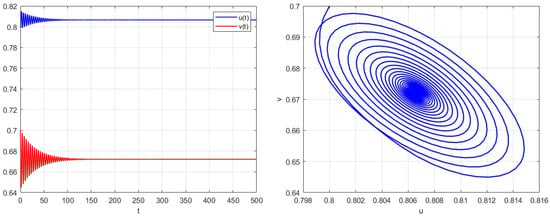 Figure 1. Trajectory plot and phase diagram of model (6) when and .
Figure 1. Trajectory plot and phase diagram of model (6) when and .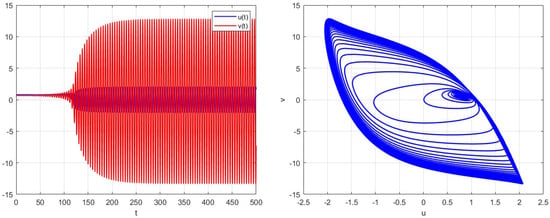 Figure 2. Trajectory plot and phase diagram of model (6) when and .
Figure 2. Trajectory plot and phase diagram of model (6) when and .
- (ii)
- Given that and , for system (5), we take , , , , , and . We then compute the equilibrium point and the critical value of the delay parameter . Moreover, and satisfy , and and satisfy . Hence, condition is necessarily satisfied and Theorem 4 is valid. If , the positive equilibrium point of the system is locally asymptotically stable (Figure 3). If , the positive equilibrium point is unstable, and the system generates periodic solutions from the positive equilibrium point (Figure 4). The time delay effect induced by the inhibition of the reactant v on u in the reaction–diffusion system (5) leads to a spatially uniform variation in the concentrations of u and v when the delay does not exceed the critical threshold. However, when the reaction delay surpasses the critical value, the concentrations of the reactants exhibit periodic oscillations in space.
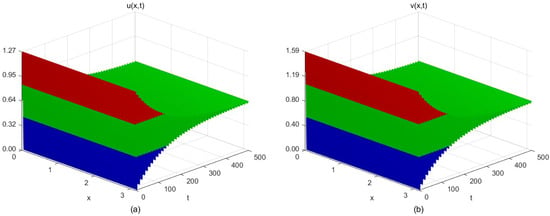 Figure 3. The space–time steady-state solution of system (5) when and . (a) Spatiotemporal steady-state solution of reactant u; (b) Spatiotemporal steady-state solution of reactant v.
Figure 3. The space–time steady-state solution of system (5) when and . (a) Spatiotemporal steady-state solution of reactant u; (b) Spatiotemporal steady-state solution of reactant v.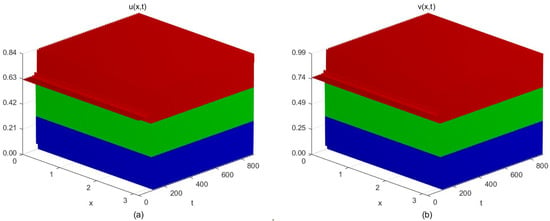 Figure 4. The periodic solutions of system (5) when and . (a) Periodic solution of reactant u; (b) Periodic solution of reactant v.
Figure 4. The periodic solutions of system (5) when and . (a) Periodic solution of reactant u; (b) Periodic solution of reactant v.
- (iii)
- In the event that , , for system (5), we take , , , , and , . Determining the equilibrium point , the threshold value of the time delay parameter . Moreover, and satisfy , , and . Hence, condition is necessarily satisfied and Theorem 5 is established. When , the positive equilibrium point of the system is locally asymptotically stable (Figure 5). When , the system generates periodic solutions from the positive equilibrium point (Figure 6). It is demonstrated that when the time delay effect induced by the linear self-decay term of the reactant v in the reaction–diffusion system (5) does not exceed the critical value, the concentrations of the reactants u and v tend to vary uniformly in space. However, when the reaction time delay surpasses the critical value, the concentrations of the reactants exhibit periodic oscillations in space.
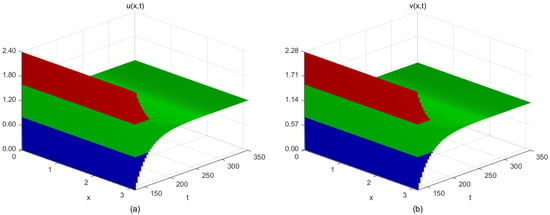 Figure 5. The space–time steady-state solution of system (5) when and . (a) Spatiotemporal steady-state solution of reactant u; (b) Spatiotemporal steady-state solution of reactant v.
Figure 5. The space–time steady-state solution of system (5) when and . (a) Spatiotemporal steady-state solution of reactant u; (b) Spatiotemporal steady-state solution of reactant v.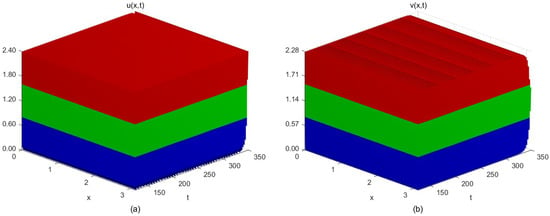 Figure 6. The periodic solutions of system (5) when and . (a) Periodic solution of reactant u; (b) Periodic solution of reactant v.
Figure 6. The periodic solutions of system (5) when and . (a) Periodic solution of reactant u; (b) Periodic solution of reactant v.
- (iv)
- In the instance that , for system (5), we take , , , , , and . We evaluate the equilibrium point and the threshold of the delay parameter . Additionally, and satisfy , and and satisfy , . Hence, condition is necessarily satisfied, and Theorem 3 remains true. As soon as , the positive equilibrium point of the system is locally asymptotically stable (Figure 7). As soon as , the system generates periodic solutions from the positive equilibrium point (Figure 8). Furthermore, it is elucidated that when the time delay effects induced by the inhibition of reactant v on u and the linear self-decay term of reactant v in system (5) are identical, these time delay effects exert a certain influence on the stability of the system. When the time delay does not exceed the critical threshold, the concentrations of reactants u and v change uniformly, whereas when the time delay surpasses the critical value, the concentrations of the reactants exhibit periodic oscillations.
 Figure 7. The space–time steady-state solution of system (5) when . (a) Spatiotemporal steady-state solution of reactant u; (b) Spatiotemporal steady-state solution of reactant v.
Figure 7. The space–time steady-state solution of system (5) when . (a) Spatiotemporal steady-state solution of reactant u; (b) Spatiotemporal steady-state solution of reactant v.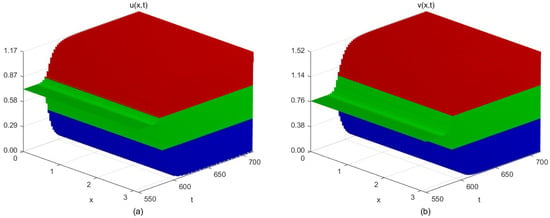 Figure 8. The periodic solutions of system (5) when . (a) Periodic solution of reactant u; (b) Periodic solution of reactant v.
Figure 8. The periodic solutions of system (5) when . (a) Periodic solution of reactant u; (b) Periodic solution of reactant v.
5. Conclusions
This study investigates a class of Boissonade reaction-diffusion models with time delays, specifically examining the delayed effects arising from the inhibition of reactant u by reactant v , the delay induced by the linear self-decay term of v , and the dynamical behavior of the system when both delays are identical. Using time delay as a key parameter, the stability of the system at equilibrium points and the existence of Hopf bifurcations under the aforementioned three scenarios are analyzed. The results indicate that when the time delay remains below a critical threshold, the positive equilibrium point exhibits local asymptotic stability, and reactant concentrations vary uniformly in space. However, once the delay exceeds the critical value, the positive equilibrium loses stability, and the system exhibits periodic oscillations, demonstrating typical characteristics of Hopf bifurcation. These findings provide a theoretical foundation for understanding and controlling chemical reaction processes with time delays. Nevertheless, the types of delays considered in this study are relatively limited. Future research could extend to nonlinear delays, multiple delays, or delays with saturation effects to further enrich the understanding of system dynamics. Moreover, since time delays are often closely related to physical conditions such as temperature and pressure, incorporating more practical factors would enhance the model’s real-world applicability. Additionally, the Hopf bifurcation analysis method employed in this study is not only applicable to chemical reaction systems but can also be extended to other nonlinear systems, particularly in control systems where input saturation, time-delay effects, or extreme solution behaviors are significant. This method can effectively predict critical conditions and reveal periodic oscillatory behaviors in such systems. Furthermore, observer design based on partial differential equations and predictive control strategies offer effective means for managing these complex systems. Future research may further explore the application of low-gain control in scenarios where delays and diffusion coexist, integrating nonlinear control theory and stability analysis methods to develop more precise control strategies. Such advancements would provide theoretical support for regulating complex reaction-diffusion systems and promote their interdisciplinary applications in chemistry, physics, biology, and beyond.
Author Contributions
Conceptualization, S.Z. and L.L.; Methodology, S.Z. and L.L.; Software, S.Z.; Validation, S.Z. and L.L.; Resources, L.L.; Data curation, S.Z.; Writing—original draft, S.Z.; Writing—review and editing, S.Z. and L.L.; Visualization, S.Z. All authors have read and agreed to the published version of the manuscript.
Funding
This research received no external funding.
Data Availability Statement
The raw data supporting the conclusions of this article will be made available by the authors on request.
Conflicts of Interest
The authors declare no conflicts of interest.
References
- Xiong, L.; Yin, W.J.; Zhang, X.G. Stabilization and circuit implementation of a novel chemical oscillating chaotic system. Circuit World 2019, 45, 93–106. [Google Scholar] [CrossRef]
- Erneux, T. Early models of chemical oscillations failed to provide bounded solutions. Philos. Trans. R. Soc. A Math. Phys. Eng. Sci. 2018, 376, 20170380. [Google Scholar] [CrossRef] [PubMed]
- Guo, G.H.; Wei, T.T.; Jia, F.J.; Abbakar, K.A. Turing instability of periodic solutions for a general Brusselator model with cross-diffusion. J. Math. Anal. Appl. 2025, 541, 128683. [Google Scholar] [CrossRef]
- Chen, M.X.; Wu, R.C.; Liu, B.; Chen, L.P. Turing-Turing and Turing-Hopf bifurcations in a general diffusive Brusselator model. ZAMM-J. Appl. Math. Mech. Für Angew. Math. Und Mech. 2023, 103, e201900111. [Google Scholar] [CrossRef]
- Li, Z.X.; Song, Y.L.; Wu, C.F. Turing instability and Hopf bifurcation of a spatially discretized diffusive Brusselator model with zero-flux boundary conditions. Nonlinear Dyn. 2023, 111, 713–731. [Google Scholar] [CrossRef]
- He, Z.C.; Zhao, Y.L. Hopf bifurcation and limit cycle of the two-variable Oregonator model for Belousov–Zhabotinsky reaction. Math. Methods Appl. Sci. 2024, 47, 14600–14609. [Google Scholar] [CrossRef]
- Liu, N.; Yu, Y.Y. Pullback and uniform exponential attractors for non-autonomous Oregonator systems. Open Math. 2024, 22, 20240071. [Google Scholar] [CrossRef]
- Dufiet, V.; Boissonade, J. Dynamics of Turing pattern monolayers close to onset. Phys. Rev. E 1996, 53, 4883. [Google Scholar] [CrossRef]
- Zhang, Z.; Huang, J.H. Dynamics of stochastic Boissonade system on the time-varying domain. Adv. Differ. Equ. 2016, 2016, 141. [Google Scholar] [CrossRef]
- Tu, J.Y. Global attractors and robustness of the Boissonade system. J. Dyn. Differ. Equ. 2015, 27, 187–211. [Google Scholar] [CrossRef]
- He, S.C.; Jonsson, E.; Martins, J.R.R.A. Adjoint-based limit cycle oscillation instability sensitivity and suppression. Nonlinear Dyn. 2023, 111, 3191–3205. [Google Scholar] [CrossRef]
- Snoun, C.; Bergeot, B.; Berger, S. Robust optimization of nonlinear energy sinks used for mitigation of friction-induced limit cycle oscillations. Eur. J. Mech.-A/Solids 2022, 93, 104529. [Google Scholar] [CrossRef]
- Ganiny, S.; Koul, M.H.; Ahmad, B. Analysis of limit cycle oscillations in dual-rate haptic rendering: Effect of dual-rate sampling. IFAC-PapersOnLine 2022, 55, 655–660. [Google Scholar] [CrossRef]
- Mauroy, A.; Mezić, I. Global computation of phase-amplitude reduction for limit-cycle dynamics. Chaos Interdiscip. J. Nonlinear Sci. 2018, 28. [Google Scholar] [CrossRef] [PubMed]
- Lin, H.R.; Wang, C.H.; Deng, Q.L.; Xu, C.; Deng, Z.K.; Zhou, C. Review on chaotic dynamics of memristive neuron and neural network. Nonlinear Dyn. 2021, 106, 959–973. [Google Scholar] [CrossRef]
- Erdmenger, J.; Jian, S.K.; Xian, Z.Y. Universal chaotic dynamics from Krylov space. J. High Energy Phys. 2023, 2023, 1–62. [Google Scholar] [CrossRef]
- Lin, H.R.; Wang, C.H.; Yao, W.; Tan, Y.M. Chaotic dynamics in a neural network with different types of external stimuli. Commun. Nonlinear Sci. Numer. Simul. 2020, 90, 105390. [Google Scholar] [CrossRef]
- Lengyel, I.; Epstein, I.R. A chemical approach to designing Turing patterns in reaction-diffusion systems. Proc. Natl. Acad. Sci. USA 1992, 89, 3977–3979. [Google Scholar] [CrossRef]
- Konow, C.; Dolnik, M.; Epstein, I.R. Insights from chemical systems into Turing-type morphogenesis. Philos. Trans. R. Soc. A 2021, 379, 20200269. [Google Scholar] [CrossRef]
- Ali, I.; Saleem, M.T. Spatiotemporal dynamics of reaction–diffusion system and its application to turing pattern formation in a gray–scott model. Mathematics 2023, 11, 1459. [Google Scholar] [CrossRef]
- Zhao, M.; Zhou, S.F. Random attractor for stochastic Boissonade system with time-dependent deterministic forces and white noises. Discret. Contin. Dyn. Syst. Ser. B 2017, 22, 1683–1717. [Google Scholar] [CrossRef]
- Boissonade, J. Self-organization phenomena in non-equilibrium chemical systems. In Origins of Life: Self-Organization and/or Biological Evolution? EDP Sciences: Les Ulis, France, 2009; pp. 23–26. [Google Scholar] [CrossRef]
- Zhang, Y. Turing Instability and Bifurcation Analysis of a Kind of Reaction-Diffusion Chemical Problem. Ph.D. Thesis, Harbin Engineering University, Harbin, China, 2015. [Google Scholar]
- Liu, N. Invariant manifolds for the nonautonomous Boissonade system in three-dimensional torus. J. Appl. Anal. Comput. 2021, 11, 3133–3156. [Google Scholar] [CrossRef]
- Abdulrahuman, A.; Chakrabarti, K.; Raina, G. Stability, convergence and bifurcation in some models of chemical kinetics. arXiv 2021, arXiv:2103.13016. [Google Scholar] [CrossRef]
- Wu, H.Y.; Lou, J.F.; Dai, Y.T.; Zhang, B.; Li, K. Multi-scale analysis of the self-vibration of a liquid crystal elastomer fiber-spring system exposed to constant-gradient light. J. Zhejiang Univ.-Sci. A 2025, 26, 652–665. [Google Scholar] [CrossRef]
- Le Cacheux, M.; Oddone, L.E.; Runikhina, S.A.; Kootstra, J.; Milias-Argeitis, A.; Harutyunyan, S.R. Experimentally guided iterative parameter estimation for predictive chemical oscillator models. Angew. Chem. Int. Ed. 2025, 64, e202511413. [Google Scholar] [CrossRef]
- Kpomahou, Y.J.F.; Adechinan, A.J.; Agbelele, J.K.; Adeyemi, C. Parametric vibrational resonance and multistability in biharmonically driven Briggs–Rauscher chemical system. Chin. J. Phys. 2025, 94, 53–65. [Google Scholar] [CrossRef]
- Song, Y.L.; Han, M.A.; Wei, J.J. Stability and Hopf bifurcation analysis on a simplified BAM neural network with delays. Phys. D Nonlinear Phenom. 2005, 200, 185–204. [Google Scholar] [CrossRef]
Disclaimer/Publisher’s Note: The statements, opinions and data contained in all publications are solely those of the individual author(s) and contributor(s) and not of MDPI and/or the editor(s). MDPI and/or the editor(s) disclaim responsibility for any injury to people or property resulting from any ideas, methods, instructions or products referred to in the content. |
© 2025 by the authors. Licensee MDPI, Basel, Switzerland. This article is an open access article distributed under the terms and conditions of the Creative Commons Attribution (CC BY) license (https://creativecommons.org/licenses/by/4.0/).